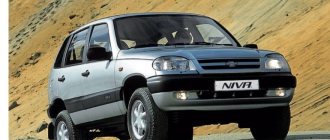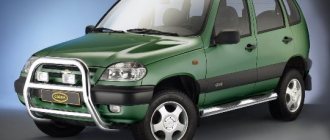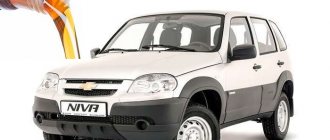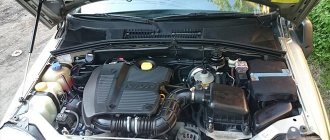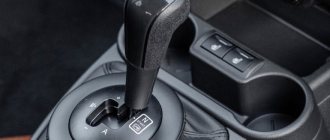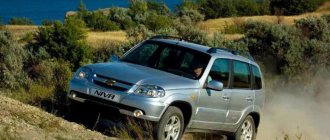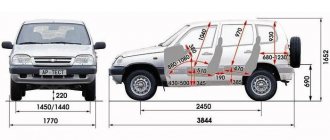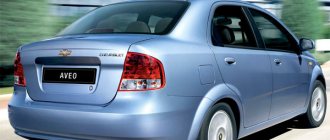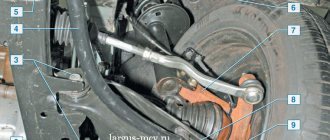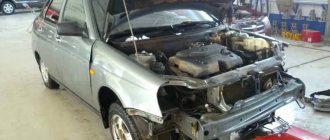For everyone who still doesn’t know what kind of engine the Chevrolet Niva has, this article has been prepared. Indeed, recently the Chevrolet Niva, whose engine capacity is 1.7 liters, has been quite popular in the CIS countries, so many are interested in the Chevrolet Niva engine and the possibility of tuning the Chevy Niva. We will now consider all these questions.
Salon
There are also plenty of shortcomings and weak points in the cabin. First of all, the small volume of the luggage compartment is noted. But this drawback is conditional; for some, the volume is quite enough; additionally, the trunk can be increased by folding the rear seats.
The second weak point in the cabin is sound insulation, or rather its complete absence. When driving inside the car, you can hear everything - the engine, the transmission, and the chassis.
The tightness of the interior is not up to par. Drafts and odors make their way inside, even on the new Chevrolet Niva with seals that have not yet dried out.
The presence of air conditioning is a positive quality, but it greatly “eats” the performance of the power plant, so drivers have to decide whether to drive in comfort, but barely, or without comfort, but a little faster.
Window lifters are a convenient thing, but on the Chevrolet Niva the plastic drive gears of the mechanism quickly wear out. After only a short period of use of the car, you can lose this convenience.
As for the dashboard, everything is in order except for the fuel level sensor. On many cars, its readings are incorrect.
Naturally, the interior plastic leaves much to be desired, since it is hard and its fastening is weak. Therefore, even a new car is characterized by squeaks in the cabin, crickets, etc.
Chevrolet Niva electronics, in particular power relays, can cause additional problems.
These relays are responsible for the operation of the cooling system fans, fuel pump, electronic control unit and ignition.
Failure of any relay other than the fan relay can render the vehicle immobile. Therefore, it is better to always have a spare set of these relays with you.
Rear suspension
But the rear suspension of the Chevrolet Niva is dependent and was created with an emphasis on reliability - the designers sacrificed comfort in exchange for practicality.
Chevrolet Niva rear suspension
The right and left rear wheels move synchronously, which reduces ergonomics and ride comfort.
Rear suspension design features:
- The springs are fixed on the platforms of the rear axle and the car body. They dampen vertical vibrations when driving over potholes or uneven roads. Unlike the front suspension, here the wheels move synchronously in opposite directions and change the angle of the car.
- The shock absorbers, like the front ones, are of a hydraulic type and work on rebound, preventing the car from swaying. They are located separately from the spring, which greatly simplifies replacement.
- Tie rods hold the rear axle and are connected to the body using special fasteners. A transverse rod prevents lateral rocking of the car, and longitudinal rods dampen vibrations during sudden braking or starting.
Since 2006, improvements have been made to improve the reliability and comfort of the suspension. The design of the chassis has not changed; the shock absorbers and silent blocks have been strengthened.
Model history
The design of a new all-terrain vehicle to replace the Niva began at AvtoVAZ back in the mid-80s. The first concept of the new Niva - VAZ - 2123 was demonstrated in 1998. Due to financial difficulties, AvtoVAZ was never able to establish mass production of the new model and carried out small-scale assembly at the pilot production facilities of AvtoVAZ OJSC from 1998 to 2002. In 2002, the license for the VAZ-2123 and the rights to the Niva brand were sold to General Motors. American engineers made more than 1,000 small changes to the design of the SUV, which allowed the Chevrolet Niva to be considered an independent model. The conveyor belt with the new Niva was launched in September 2002.
From November 2006 to the end of April 2008, about 1000 Chevrolet Niva FAM-1 were produced. The car received the index 21236 and was equipped with an Opel Z18XE engine (122 hp) and a 5-speed Aisin manual transmission with a transfer case in one block.
In March 2009, the model underwent restyling, receiving the factory VAZ index - 212300-55. The Italian design studio “BERTONE” was responsible for updating the appearance of the car.
Restyled version
In 2009, the manufacturer restyled its model, the development of which was carried out by the design studio from Italy Stile Bertone. This modification was produced in 5 trim levels: L, LC, LE, GLS, GLC.
Chevrolet Niva restyled version
Last spring, the line of the restyled version was replenished with another trim level – LE+, which was created on the basis of the GLC version. This car received a modern security system, air conditioning, new wheels and tires, and protection for the rear bumper.
Starting from the end of autumn 2015, all manufactured modifications are equipped with modernized engines of the modern Euro-5 standard.
Body and external elements
The body is still quite reliable, with the exception of the wheel arches. If you do not treat them with protective agents in a timely manner and do not protect them with plastic fender liners, pockets of corrosion will appear on the arches very quickly.
It is noted that not enough paint is used to paint the plastic elements of the body, so the paint layer quickly begins to come off from the plastic elements.
At first it was indicated that this car received a nameplate on the radiator grille from Chevrolet.
But our specialists attached it, and they couldn’t come up with anything better than putting the badge on double-sided tape.
As a result, washing and the use of high-pressure washing units can easily knock off the nameplate. Therefore, owners often either wash the car themselves, or at the car wash they warn that high-pressure water should not be applied to the nameplate.
Many people note that the head light on the Chevrolet Niva is very decent, but even here it was not without troubles.
After washing or driving in the rain, condensation forms on the inside of the headlight lenses.
Regarding the headlights, the use of weak housings for the side lamps is also noted. As a result, the housings quickly melt.
After purchasing a car, it is better to immediately replace the standard lamps with LED ones to avoid this problem.
Test Drive
Years don't matter
The Russian all-terrain vehicle has been sitting on the assembly line for many years without any special changes in appearance. However, its design does not become outdated and is still attractive.
It is worth noting the rounded headlight optics, expressive bumpers with nice stampings, a laconic radiator grille, as well as roof rails.
Body
The body of the Chevy Niva begins to bloom after 6-7 years of operation. Red dots appear on the corner of the gas tank flap, at the junction of the roof and pillars, on the sills, at the bottom of the rear fenders and the trunk door. The trim between the rear bumper and the trunk is peeling off and starting to rust. The paint is blistering on the arches and hood.
Chevrolet Niva 2009 - present
The rear and front bumpers, especially after restyling, are only suitable for driving on asphalt and light off-road. The rear bumper guides are mounted on rivets, which weaken over time, causing a gap to appear between the bumper and the body.
The side members under the bottom of the car - in their middle part - are not strong enough. When installing a jack under them, dents may remain. Squeaks may also occur when the steering wheel is rotated - this is what the spar “breathes” and “gives” protection. It is treated by placing rubber from pieces of a car inner tube to the side member under the protection mount.
The upper inner edge of the trunk door, in contact with the seal, is worn down to metal. Due to poor performance of the rear door lock, problems may arise with opening it. To do this, you need to press the upper right corner of the door with your left hand and try again. The lock itself may fail due to corrosion after 6-7 years of operation.
Over time, the bolt holding the antenna to the roof may loosen, allowing water to leak through. You can tighten it by removing the plastic trim around the interior mirror.
There is often a gap at the driver's door. To eliminate it, you need to replace the brass bushing (600 rubles). The fastenings of the external handles also weaken, which is why they begin to move away from the door along with the seal. To tighten them, you will have to remove the inner door trim.
The velvet covers on the doors scratch the glass over time. And the glass guides often allow the glass to skew when raising or lowering. Electric windows fail after 6-8 years of operation due to oxidation of the contacts. Electric motors for lowering/raising windows fail more often. Often the motor comes back to life after disassembling and cleaning.
Design and principle of operation of the front suspension
When creating a domestic SUV, engineers planned a car for a comfortable ride, which each owner could maintain independently. At the same time, I wanted to create something new so as not to be inferior to competitors.
In 2002, the first SUV equipped with an independent front spring suspension rolled off the assembly line. This design ensures a comfortable ride:
- The upper and lower suspension arms of the Niva Chevrolet are mounted on silent blocks and connected to the steering knuckle with ball joints. They ensure the movement of the right and left wheels in a vertical plane independently of each other. This design allows you to confidently drive the car on uneven roads.
- Shock absorbers and springs work together to smooth out bumps and prevent the vehicle from rocking. For less vertical runout, there is a rebound and compression stroke buffer.
- The anti-roll bar consists of a transverse beam and rubber seals. It provides tight traction at high speeds on sharp turns - when one side of the car leans, the other side also presses to the ground.
The front suspension is very ergonomic and well thought out - it allows you to confidently feel the road in any weather
During constant use, you must remember to check the wheel alignment, which is adjusted with washers between the lever axis and the bracket, and also pay attention to the front hub bearing
Power point
Let's start with the “heart” of this car – the engine. It’s worth noting right away that the unit installed on this SUV does not pull at all, a car that is designed for off-road capability.
Power 80 l. With. at 1.7 liters the volume is not enough for this car; it is more suitable for a passenger car.
You shouldn't expect agility on the road from a Chevrolet Niva equipped with such an engine. Since this is, after all, an SUV, you don’t have to look at its speed indicators, and the figure stated in the documentation of 160 km/h is quite enough for it.
Using air conditioning while driving can further reduce the already “dull” performance. With the air conditioner running, the engine actually behaves like a “vegetable”.
The car strongly “resists” acceleration, so forget about overtaking and maneuvers that require sharp acceleration.
As for the technical performance of the power unit, it is not bad. The installation does not cause any major problems other than routine maintenance.
The only weak point in the engine is the crankshaft seals. On some cars they don’t even last 30 thousand km.
Permanent all-wheel drive on this car is good, but only for driving on country roads. In urban conditions, this advantage becomes a disadvantage - fuel consumption in the city of the Chevrolet Niva is high. The car consumes over 10 liters.
Using an air conditioner can significantly increase fuel consumption.
Now on to the power plant systems.
One of the most problematic in the Chevrolet Niva is the cooling system, or rather its components.
The expansion tank of the system is “flimsy” and cracks often appear on it, through which coolant leaks. Some owners change this tank almost every year.
The water pump can also cause problems. On some cars, the pump fails regularly, but such a nuisance does not happen on all Chevrolet Nivas.
The power supply system does not cause any complaints from owners; it is reliable when properly cared for. The only thing that can happen to it is the failure of the sensors (mass air flow sensor, mass air flow sensor, DPKV).
But problems with sensors are common to many cars, so it is wrong to consider them only the Chevrolet Niva’s weak point.
The exhaust gas removal system is also reliable, but there are some issues with it.
The catalyst of this system is located close to the bottom, which is why heat from the catalyst is constantly transferred to it. And if in winter this can even be considered an advantage - some kind of additional floor heating, but in summer there is no need for additional heat in the cabin.
Well, the catalyst itself is already a “headache” for the owner. A couple of refills with low-quality gasoline, and the device is due for replacement due to burnout or severe blockage of its cells.
And since the catalyst is an expensive element, this problem is also unpleasant from the financial side. An alternative solution is to cut out the catalyst and use a resonator instead.
There is nothing to say about the lubrication system; it copes with its duties well and does not cause problems.
But electrical equipment causes trouble. The weak point in this system is the generator. It fails quite often; on many cars it is replaced under warranty within the first year of operation.
Some owners, in order to avoid problems in the future, simply select and install a similar element from a foreign car instead of a standard generator.
Electrical equipment
The most common failure of the window lifter mechanism occurs. This can happen even in the first six months. Many problems came to the Chevrolet Niva from the Niva 2121 model. These are the starter and generator. We must remember that these components can be replaced under warranty, so it is important to undergo all maintenance at the dealer on time. Over time, problems with the fuel sensor may appear. Due to exposure to high temperatures, the wiring leading to the radiator fan is destroyed, causing a short circuit and blown fuses.
Enough about the bad things the owners say
Despite all these shortcomings, the Chevrolet Niva is characterized by its owners mostly on the positive side. All these weak points for a real driver who is not afraid to delve into his car are not critical.
Of course, the same owners “scold” the Chevrolet Niva for a large number of shortcomings, but at the same time they try to eliminate them, as well as improve the car by going through and replacing the chassis, applying sound insulation, and eliminating all other shortcomings and weak points.
For all its weaknesses and shortcomings, the Chevrolet Niva is in demand, and for several reasons.
The first is the cost of the car.
It is difficult to find a quite good SUV for such a price, even if it is of domestic production, albeit with an American name.
The second is cross-country ability.
The Chevrolet Niva drives off-road, and drives well. It will not overcome severe off-road conditions, but it will easily overcome moderate ones.
This car is perfect for lovers of outdoor activities outside the city, fishermen, and dacha owners.
It is worth noting that not every foreign crossover is capable of overcoming the off-road conditions that the Chevrolet Niva can overcome. And this despite the frankly weak power plant.
Third, high maintainability.
Most faults, due to the simplicity of the design, are eliminated in garages using improvised means.
Many people even like that this SUV, like most domestic cars, can be repaired “in the field, on your knees” without using any special tools.
Fourth is the availability of spare parts.
You can find spare parts and consumables for the Chevrolet Niva almost everywhere. At the same time, their cost is not as high as for foreign cars.
Chassis
There are also some weaknesses here. Ball joints do not last long, but if you take into account the condition of the roads, and the supports themselves are just consumables, then there is nothing special about their failure, the same goes for oil seals, bushings, silent blocks.
The elements of the steering linkage are also the weak point of the chassis, so constant monitoring of its elements is required.
The weak point in the Chevrolet Niva chassis is the hubs. Their bearings break quite quickly and require replacement.
Proof that the hubs are the weak point in this car are reviews from owners, in which they indicate that they encountered a problem when, when driving, the wheel “went away” along with the hub due to a broken bearing.
Another weak point of the chassis is the front shock absorbers. Their resource for Chevrolet Niva is not very large.
Many people also note the need to install another anti-roll bar, since the Chevrolet Niva rolls significantly when maneuvering.
Car owners still complain about the lack of anti-lock brakes. This flaw is really serious. Even restyling did not bring such necessary equipment to the car.
Chassis
The weakest elements in this system will be the balls, steering linkage, rods and seals. It is necessary to check the hubs periodically. Typically, problems with the wheel bearing manifest themselves in the first 30 thousand kilometers. Due to off-road use, CV joints often fail. This occurs due to dust and dirt getting on the anthers, as a result of which they tear faster.
Engine
The all-terrain vehicle is equipped with a 1.7 liter (80 hp) gasoline engine with a timing chain drive. The design of the standard timing belt tensioner is not reliable enough - it allows the chains to jump. After starting a cold engine, the hydraulic chain tensioner (HNC) often rattles until the engine warms up. The weak points of the tensioner are the unreliable design of the aluminum oil supply tube and check valve. Replacing the GNC may be necessary after 50,000 km. A good alternative to a standard tensioner can be an analogue that has a longer service life. The chain stretches after a mileage of more than 100,000 km.
Niva VAZ - 2123 1998 - 2002
If the engine immediately stalls after being parked for a long time, then most likely you will need to replace the throttle position sensor (TPS, 300 rubles). This can happen already with a mileage of just over 10 thousand km. Replacing high-voltage wires may be necessary when the mileage is more than 60 - 80 thousand km. At around 80-90 thousand km, valve burnout occurs. And the rear crankshaft oil seal begins to “snotty” after 100 thousand km. If, after a mileage of more than 100 - 120 thousand km, the traction is lost and the engine starts to stall, then the ignition module may have come to an end.
With the same mileage, a knocking sound from the hydraulic compensators may occur. This can lead to breaking of the thread for the hydraulic compensator, destruction of the ramp and burning of the valves, which in turn will reduce compression in the cylinders. To avoid illness, car service centers recommend keeping the oil level closer to the MAX mark. If the knocking does not stop, it is better to replace the hydraulic compensators.
With a mileage of more than 100 thousand km, some engines begin to consume more oil - about 200 - 300 g. per 1000 km. The norm established by the manufacturer is 500 g. per 1000 km. The root cause is “hardened” valve stem seals that require replacement. Perhaps after 120 - 140 thousand km the oil pump will need to be replaced.
The idle speed regulator (IAC, about 500 rubles) can fail at more than 130 - 150 thousand km. Floating idle speed will indicate the need to replace it. A mass air flow sensor (MAF) will cost more - about 2,000 rubles, but it usually lasts more than 100,000 km.
The cylinder head gasket burns out after a mileage of more than 150 thousand km. By this time, the starter also “fits”.
In general, there are almost no serious breakdowns. Throughout the “life” of the motor, its unstable operation, starts not on the first try, and tripping are often observed. As a rule, this is due to failures of the IAC, TPS and crankshaft position (DPKV) sensors, as well as a malfunction of the fuel pump itself or clogging of its receiving grid.
In search of “happiness” and reliability of the engine, some owners replace the standard cylinder head with a new INA. But reviews of the results of such a reshuffle are not clear-cut. Some people notice improvements, but the remaining changes in the operation of the engine do not see. Some also replace the standard camshaft 213 with 214, due to which there is more traction at the bottom and the idle speed is more stable.
Front panel of Chevrolet Niva 2002 - 2009.
Noise from a running fuel pump is a common occurrence. It can be heard even on completely new copies. With a mileage of more than 150-170 thousand km (6-8 years of operation), it would be a good idea to look under the bottom. In the place where the fuel pipes come out of the body and go around the side member, a lot of dirt accumulates under the metal casing. As a result, a corrosion center appears that destroys the integrity of the pipeline. The danger lies in the occurrence of gasoline leaks and the possibility of fire.
The engine cooling system is disappointing with frequent radiator leaks. The coolant reservoir often turns into a consumable, bursting at the seam after 30 - 40 thousand km, or even more often. With a mileage of more than 60-80 thousand km, the lower pipe going to the radiator requires tightening, which often breaks off. The location of the pipe and clamp cause difficulties during this procedure.
And with a mileage of just over 20,000 km, the thermal shield of the exhaust manifold may burn out (the mounting bracket is destroyed), which, when the engine is running, begins to make unpleasant sounds reminiscent of rattling. The oxygen sensor (lambda probe) lasts up to 80 - 100 thousand km. With a mileage of more than 100 thousand km, the catalyst will most likely need to be replaced.
According to owner reviews, the average fuel consumption is about 9 - 10 liters per 100 km, in the city it is about 13.5 - 14.5 liters.
Weaknesses and malfunctions of the Chevrolet Niva
On the Internet you can find many “terrible” descriptions of problems and breakdowns of the Chevrolet Niva. For example, that already at 50,000 km, problems with the timing chain may begin, the starter may fail, the clutch will burn out, the transfer case will “snot”, through metal corrosion will begin, and so on. But in practice, as we see, you can find a huge number of Shnivas on the roads and in pretty good condition, and there is also considerable demand for the car aftermarket. And would people buy a “bucket of bolts” that needs to be constantly repaired and invest their hard-earned money into it? I think no. The Chevy Niva is actually a good SUV, and many problems about it are simply made up and exaggerated many times over.
Here I will describe what you should check before purchasing, what you should pay attention to, and what problems may arise. After all, you see, the same car can be in completely different states, depending on its owner and operating conditions.
Also interesting: What is the difference between the Niva Urban and the regular Niva?
1) Corrosion. This is a really common disease of Shniv bodies, since only a part of the parts were galvanized at the factory, and even then of poor quality. Rust, even in 5-6 year old cars, can be found in the area of chips - hood, fenders, side members. And the most problematic places remain the rear wings and arches.
Therefore, it is recommended to carry out additional anti-corrosion treatment for this vehicle. And it’s very cool if you come across such a copy, the previous owner of which has already treated the body with anticorrosive and installed fender liners.
2) Timing chain. On the Internet you can find stories where the chain jumped already at 60-80 thousand kilometers and had to be changed. In practice, this disease does not occur on every car, but this cannot be denied. Therefore, it is necessary to periodically monitor the condition of the chain, and usually replacing the chain tensioner and pump solves this problem.
For example, a friend’s Chevy Niva already has 110,000 km on it, and he hasn’t done anything to the chain. Everything works fine. But he says that with a mileage of about 150,000 km it will be necessary to change the chain, tensioner, and pump. And also change the hydraulic compensators.
When inspecting, listen to see if there are any extraneous noises in the engine operation.
3) Brake pads fail quite quickly. But this is a consumable material, especially since it is worth considering that this car is usually often used in off-road conditions - sand, water, all this quickly corrodes the pads.
4) When inspecting, check to see if the axle gearbox and transfer case are leaking. There is such a disease on Shnivy, but this nuance, again, does not occur on every car and may not appear until 150,000 km.
And it is also important that the transfer case and transfer case do not make too much noise when driving, otherwise you may end up having to completely replace these components. Or it will be enough to replace the clutch or the release bearing itself. A little noise is quite acceptable, because they cannot work absolutely without noise.
5) The factory 80-amp generator KZATE-80A lasts quite a long time, although some write that it fails even before 100,000 km. Some people change it to a more powerful one, for example, the 100-120 ampere KZATE-120A. But you shouldn’t touch it if there are no problems. In addition, you can go to an auto electrician and resolve the issue without a complete replacement.
6) As for shock absorber bushings, hubs, oil seals, silent blocks, bearings, their serviceability will depend on how and where the owner drove. If you didn’t skimp on the off-road, jumped on the pits, then of course the parts will wear out quickly, and if you moved at a moderate pace and treated them with care, then they will last about 80-100 or more thousand kilometers.
Ball joints have to be changed every 35-40 thousand km.
7) Expansion tanks on Nivas have a short lifespan, and in 80-100 thousand km you can change them three times.
 The starter usually dies after 90,000 km, some earlier, some later. The cost of a good starter is 2500-3000 rubles.
The starter usually dies after 90,000 km, some earlier, some later. The cost of a good starter is 2500-3000 rubles.
9) The interior, naturally, does not feature super-high-quality finishing materials, and there is plenty of noise in it, but for the money it is quite tolerable. The weak point is the steering wheel upholstery, which peels off after 30,000 km. The solution is to install an overlay.
To summarize, I will say what is obvious to me. Chevy Niva is a decent SUV, more comfortable and roomy compared to the VAZ Niva. However, when buying it, you should understand that you will have to invest, but how much depends on the specific option. I meant a used car. I'm not saying anything about the new one. So when buying, inspect everything thoroughly, go to the service center, go to the lift, listen to the internal combustion engine, gearbox, manual transmission and everything else.
Corrosion - 2003 model. Usually, when a car has fender flaps, it is a sign that they are hiding rust.
Valve train chain
Chevrolet Niva transfer case leaking
The tank burst - usually due to temperature changes
covered the steering wheel
Advantages and disadvantages of the Niva Chevrolet suspension
A comprehensive assessment of the suspension takes into account the study of the design, its effect on handling and maneuverability
You also need to take several factors into account
Pros of car suspension
Positive features include:
- excellent maneuverability due to high ergonomics and adaptive design;
- maintainability - you can replace worn parts yourself according to the instructions;
- Availability of spare parts - always available in any store.
In terms of costs, repairing the front or rear suspension of a Chevrolet Niva is cheaper than foreign cars - the price of spare parts is 2-3 times lower. The parts have a shorter lifespan, but even with scheduled maintenance, it is more profitable to maintain a domestic SUV.
Disadvantages of the Chevrolet Niva suspension
- vibrations - mainly due to the rear dependent suspension or due to “oak” rubber bands when replacing them is missed;
- low quality of spare parts - if you buy cheaper analogues instead of original ones;
- increased fuel consumption - mainly due to the heavy rear gearbox.
Some people note other shortcomings, such as play in the front hub due to a worn tapered bearing, ball joints or silent blocks. But the cause of these malfunctions is poor vehicle maintenance and missed scheduled maintenance.
Second generation Niva Chevrolet
The start of production of the Chevrolet Niva 2 was planned for this year. As already noted, the project is currently suspended, so it is not possible to say anything about the new car with complete confidence.
Second generation Chevrolet Niva
According to data that has appeared on the Internet, welding and stamping of the body for the second generation Niva will be carried out in a new workshop, which was built specifically for this purpose. The new model will be equipped with a 135-horsepower engine from PSA Peugeot Citroën, the transfer case and gearbox will be Italian and Indian, respectively.
The concept of the new version has already been demonstrated, so we can only hope that mass production will begin in the near future.
Tweet
Let's sum it up
Yes, the Chevrolet Niva has many shortcomings and weak points, it breaks down more often than foreign cars, and comfort is minimal. But with proper care and all routine maintenance, this car will serve its owner “faithfully.”
In general, this car copes with its direct responsibility - it overcomes off-road conditions, albeit average ones, after all, the Chevrolet Niva is not a full-fledged SUV, so even such off-road performance indicators for this car are a significant achievement. And all cars have shortcomings, to a greater or lesser extent.
Chevrolet Niva is still a worthy representative of the domestic automobile industry, even if it is a joint development with GM. If the car were bad, it would not have been awarded the title of “Car of the Year” twice in the SUV class.
In addition, the second generation of this car is approaching, so let’s see if the designers can correct all the weak points and bring the Chevrolet Niva to a decent level in terms of quality and performance.
Market price
| Auto | State | Price (rubles) |
| VAZ 2123 | boo | no data |
| Chevrolet Niva | boo | from 89 thousand |
| Chevrolet Niva (rest.) | boo | from 240 thousand |
| Chevrolet Niva (rest.) | new | from 585 thousand |
